Kia Rio: Cylinder Block / Crankshaft
Repair procedures
| • |
Use fender covers to avoid damaging painted surfaces.
|
| • |
To avoid damaging the cylinder head, wait until the engine coolant
temperature drops below normal temperature before removing it.
|
| • |
When handling a metal gasket, take care not to fold the gasket
or damage the contact surface of the gasket.
|
| • |
To avoid damage, unplug the wiring connectors carefully while
holding the connector portion.
|
|
| • |
Mark all wiring and hoses to avoid misconnection.
|
| • |
Turn the crankshaft pulley so that the No.1 piston is at TDC
(Top dead center).
|
|
| 1. |
Remove the engine assembly from the vehicle.
(Refer to Engine and Transaxle Assembly - "Engine and Transaxle Assembly”)
|
| 2. |
Remove the transaxle assembly from the engine assembly.
(Refer to Manual Transaxle System - "Manual Transaxle")
|
| 3. |
Remove the flywheel.
(Refer to Cylinder Block - "Flywheel")
|
| 4. |
Install the engine to engine stand for disassembly.
|
| 5. |
Remove the timing chain.
(Refer to Timing System - "Timing Chain”)
|
| 6. |
Remove the intake manifold.
(Refer to Intake and Exhaust System - "Intake Manifold")
|
| 7. |
Remove the exhaust manifold.
(Refer to Intake and Exhaust System - "Exhaust Manifold")
|
| 8. |
Remove the cylinder head assembly.
(Refer to Cylinder Head Assembly - "Cylinder Head")
|
| 9. |
Remove the water pipe.
(Refer to Cooling System - "Thermostat")
|
| 10. |
Remove the water temperature control assembly.
(Refer to Cooling System - "Thermostat")
|
| 11. |
Remove the oil pan and oil screen.
(Refer to Lubrication System - "Oil Pan")
|
| 12. |
Remove the ladder frame.
(Refer to Cylinder Block - "Cylinder Block")
|
| 13. |
Remove the piston and connecting rod assemblies.
(Refer to Cylinder Block - "Piston and Connecting Rod")
|
| 14. |
Remove the main bearing caps (A) and check oil clearance.
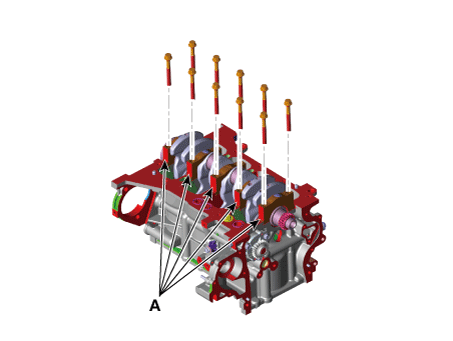
|
| 15. |
Check the crankshaft end play.
|
| 16. |
Lift the crankshaft (A) out of engine, being careful not to damage journals.
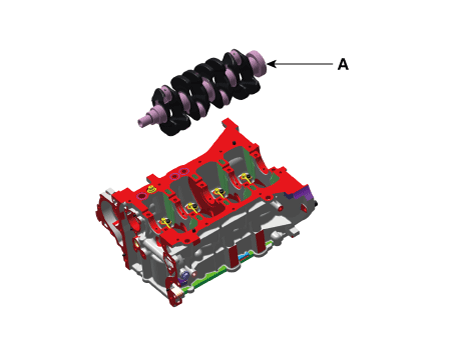
|
Arrange the main bearings and center bearings in the correct
order.
|
|
| 1. |
Check the connecting rod bearing oil clearance.
| (1) |
To check main bearing-to-journal oil clearance, remove the main
bearings.
|
| (2) |
Clean each main journal and bearing half with a clean shop tower.
|
| (3) |
Place one strip of plastigage across each main journal.
|
| (4) |
Reinstall the bearings and bolts as following method with specified
torque. In the sequence.
|
Tightening torque :
17.7 - 21.6 N·m (1.8 - 2.0 kgf·m, 13.0 - 15.9 lb·ft)
+ 88 - 92°
|

|
• |
Do not turn the crankshaft.
|
|
• |
Always use new crankshaft main bearing cap bolts.
Crankshaft main bearing cap bolts are torque-to-yield
bolts designed to be permanently elongated beyond
the state of elasticity when torqued, so if the
bolts are removed and reused, it may cause the bolts
to break or fail to maintain clamping force.
|
|
|
| (5) |
Remove the cap and bearing again, and measure the widest part
of the plastigage.
|
Main bearing oil clearance :
0.006 - 0.024 mm (0.0002 - 0.0009 in)
Main bearing oil clearance include big hole expension
deformation :
0.021 - 0.039 mm (0.0008 - 0.0015 in)
|
|
| (6) |
If the plastigage measures too wide or too narrow, remove the
upper half of the bearing, install a new, complete bearing with
the same color mark (select the color as shown in the next column),
and recheck the clearance.
|
Do not file, shim, or scrape the bearings or the caps
to adjust clearance.
|
|
| (7) |
If the plastigage shows the clearance is still incorrect, try
the next larger or smaller bearing (the color listed above or below
that one), and check clearance again.
|
If the proper clearance cannot be obtained by using the
appropriate larger or smaller bearings, replace the crankshaft
and start over.
|
|
If the marks are indecipherable because of an accumulation
of dirt and dust, do not scrub them with a wire brush or
scraper. Clean them only with solvent or detergent.
|
Cylinder block crankshaft journal bore mark location
Letters have been stamped on the block as a mark for the size
of each of the 5 main journal bores.
Use them, and the numbers or bar stamped on the crank (marks
for main journal size), to choose the correct bearings.

Grade
|
Mark
|
Cylinder Block Crankshaft journal Bore Inner Diameter
|
a
|
A
|
52.000 - 52.006 mm
(2.0472 ~ 2.0475 in)
|
b
|
B
|
52.006 - 52.012 mm
(2.0475 - 2.0477 in)
|
c
|
C
|
52.012 - 52.018 mm
(2.0477 - 2.0480 in)
|
Crankshaft Main Journal Mark Location
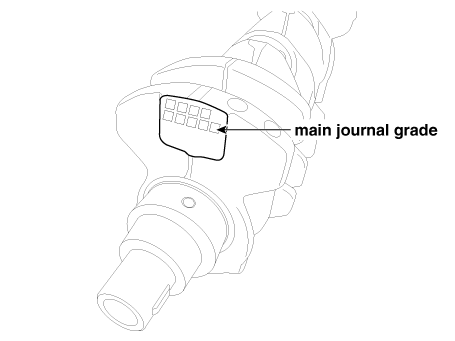
Discrimination
Of Crankshaft Main Journal
Class
|
Mark
|
Crankshaft main journal outer diameter
|
I
|
1
|
47.954 - 47.960 mm
(1.8879 - 1.8881 in)
|
II
|
2
|
47.948 - 47.954 mm
(1.8877 - 1.8879 in)
|
III
|
3
|
47.942 - 47.948 mm
(1.8874 - 1.8877 in)
|
Crankshaft Main Bearing Mark Location

Mark
|
Color
|
Crankshaft Main Bearing Thickness
|
A
|
Blue
|
2.026 - 2.029 mm
(0.0797 - 0.0798 in)
|
B
|
Black
|
2.023 - 2.026 mm
(0.0796 - 0.0797 in)
|
C
|
None
|
2.020 - 2.023 mm
(0.0795 - 0.0796 in)
|
D
|
Green
|
2.017 - 2.020 mm
(0.0794 - 0.0795 in)
|
E
|
Yellow
|
2.014 - 2.017 mm
(0.0793 - 0.0794 in)
|
|
| (8) |
Select the bearing by using selection table.
Crankshaft Main Bearing Selection Table
Crankshaft Main Bearing
|
Cylinder Block Crankshaft Journal Bore Mark
|
a(A)
|
b(B)
|
c(C)
|
Crank shaft main journal mark
|
I(1)
|
E(Yellow)
|
D(Green)
|
C(None)
|
II(2)
|
D(Green)
|
C(None)
|
B(Black)
|
III(3)
|
C(None)
|
B(Black)
|
A(Blue)
|
|
|
| 2. |
Check crankshaft end play.
Using a dial indicator, measure the thrust clearance while prying the
crankshaft back and forth with a screwdriver.
|
Standard end play :
0.07 - 0.25 mm ( 0.0028 - 0.0098 in)
|

If the end play is greater than maximum, replace the center bearings
as a set.
|
Thrust bearing thickness :
1.925 - 1.965 mm (0.0757 - 0.0774 in)
Crankshaft end play :
0.07 - 0.25 mm (0.0028 - 0.0098 in)
|
|
| 3. |
Inspect the crankshaft main journals and pin journals.
Using a micrometer, measure the diameter of each main journal and pin
journal.
|
Main journal diameter :
47.942 - 47.960 mm (1.8874 - 1.8881 in)
Pin journal diameter :
38.954 - 38.972 mm (1.5336 - 1.5343 in)
|
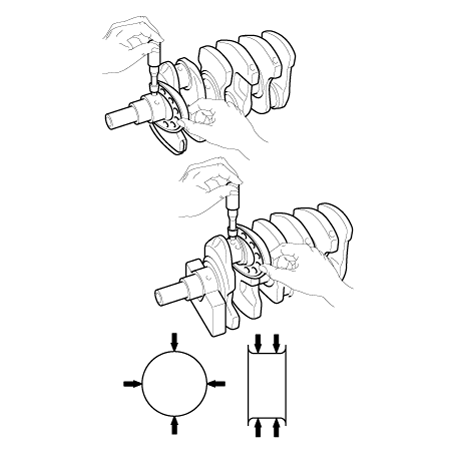
|
| 1. |
Install the crankshaft main bearings.
|
Upper bearings have an oil groove of oil holes; Lower bearings
do not.
|
| (1) |
Align the bearing claw with the claw groove of the cylinder block,
push in the 5 upper bearings (A).
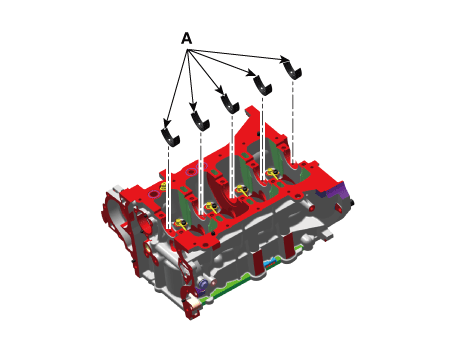
|
| (2) |
Install the thrust bearings.
Install the 2 thrust bearings (A) under the No.3 journal position
of the cylinder block with the oil grooves facing outward.
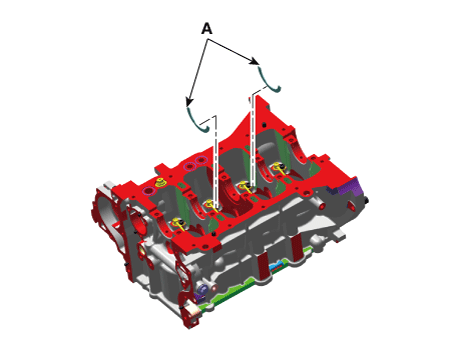
|
| (3) |
Install the crankshaft lower main bearing.
Align the bearing claw with the groove of the crankshaft lower
bearing and crankshaft main bearing cap.
|
|
| 2. |
Place the crankshaft (A) on the cylinder block.

|
| 3. |
Install the main bearing cap (A).
| •
|
Always use new crankshaft main bearing cap bolts. Crankshaft
main bearing cap bolts are torque-to-yield bolts designed
to be permanently elongated beyond the state of elasticity
when torqued, so if the bolts are removed and reused, it
may cause the bolts to break or fail to maintain clamping
force.
|
| •
|
If any of the bearing cap bolts are broken or deformed,
replace it.
|
|
| (1) |
Apply a light coat of engine oil on the threads and under the
bearing cap bolts.
|
| (2) |
Install and uniformly tighten the 10 bearing cap bolts, in several
passes, in the sequence shown.
|
Tightening torque :
17.7 - 21.6 N·m (1.8 - 2.0 kgf·m, 13.0 - 15.9 lb·ft)
+ 88 - 92°
|
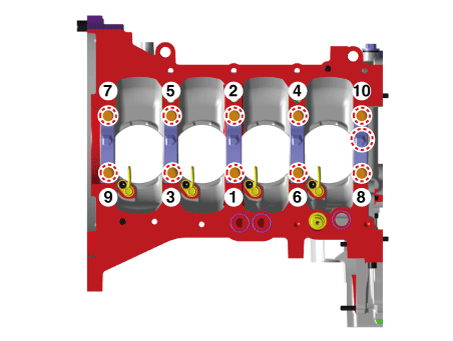
|
| (3) |
Check that the crankshaft turns smoothly.
|
|
| 4. |
Check the crankshaft end play.
|
| 5. |
Assemble the other parts in the reverse order of disassembly.
|
Repair procedures
Disassembly
•
Use fender covers to avoid damaging painted surfaces.
...
Repair procedures
Disassembly
•
Use fender covers to avoid damaging painted surfaces.
...
Other information:
Specifications
Specification
Manifold Absolute Pressure
Sensor (MAPS)
▷ Type: Piezo-resistive pressure sensor type
Pressure
[kPa (kgf/cm², psi)]
Output Voltage (V) [Vref = 5V]
20.0 (0.20, 2.9)
0.79
46. ...
Repair procedures
Replacement and air bleeding
Never remove the radiator cap when the engine is hot. Serious scalding
could be caused by hot fluid under high pressure escaping from the radiator.
...
 Piston and Connecting Rod
Piston and Connecting Rod Cylinder Block
Cylinder Block












